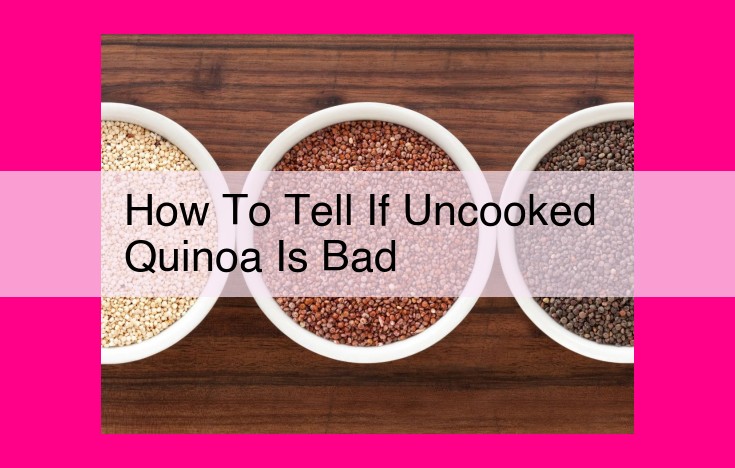How To Identify Spoiled Uncooked Quinoa: A Comprehensive Guide For Food Safety

To determine if uncooked quinoa is spoiled, inspect it for:
- Changes in appearance: Discoloration, mold growth, or insect infestation
- Rancid or sour odor
- Strange or bitter taste
- Reduced nutritional value due to nutrient depletion
Discard any quinoa that exhibits these signs to ensure food safety and prevent illness.
Understanding Food Spoilage: Signs and Causes
Food spoilage is a natural process that occurs when microorganisms like bacteria, yeast, or mold break down the components of food. Understanding the signs and causes of food spoilage is crucial to ensure food safety and prevent foodborne illnesses.
Signs of Food Spoilage:
- Changes in Flavor: Sour, bitter, or off flavors are often indicative of spoilage. These flavors can be caused by the production of acids, gases, or other compounds by microorganisms.
- Changes in Texture: Food that becomes slimy, mushy, or stringy may have been spoiled. These changes are often caused by the breakdown of proteins and carbohydrates by bacteria or mold.
- Changes in Color: Discoloration, darkening, or bleaching can indicate spoilage. These changes may be caused by the growth of pigments or the breakdown of enzymes.
- Changes in Smell: Sour, yeasty, or moldy odors are often signs of spoilage. These odors are produced by the metabolic activities of microorganisms.
Factors Influencing Food Shelf Life
Understanding the factors that influence food shelf life is crucial for preventing spoilage and ensuring safe consumption. Various elements can significantly impact how long food remains fresh and nutritious.
Temperature
Temperature plays a pivotal role in food preservation. Cold temperatures slow down microbial growth, extending the shelf life of perishable items. Refrigeration is essential for most foods, especially those that contain moisture and are susceptible to bacterial contamination.
Humidity
Humidity levels affect food’s moisture content. High humidity can promote mold growth, while low humidity can cause food to dry out. Finding the right balance of humidity is essential, particularly for products like bread and fruits. Proper packaging and storage methods can help regulate humidity levels.
Packaging Materials
The type of packaging used can significantly impact food shelf life. Airtight containers prevent oxygen from reaching food, inhibiting oxidation and bacterial growth. Vacuum-sealed packaging removes air and further extends the shelf life of meats and other perishable products. The choice of packaging materials should consider the food’s specific characteristics and the desired storage duration.
Smart Home Food Storage: A Guide to Preserve Food and Minimize Spoilage
Understanding how food spoils is key to extending its shelf life. Common signs of spoilage include changes in flavor, texture, color, and smell. By being mindful of these signs, you can prevent foodborne illnesses and maximize the freshness of your food.
Temperature is a critical factor that influences food preservation. Keep perishable foods refrigerated at or below 40°F (4°C). This will slow down the growth of bacteria and other microorganisms that cause spoilage. Consider using refrigerator thermometers to ensure your appliance maintains the proper temperature.
Humidity also plays a role. High humidity can promote mold growth, so store produce in ventilated containers or use paper towels to absorb excess moisture. Proper packaging is equally important. Airtight containers or vacuum sealers prevent moisture loss and the entry of oxygen, which can lead to oxidation and spoilage.
Freezing is another effective way to preserve food. Freeze meats, poultry, seafood, and other perishable items at 0°F (-18°C) or below. Rapid freezing preserves nutrients and flavor and inhibits bacterial growth. Thaw frozen foods in the refrigerator or under cold running water to avoid temperature fluctuations that can promote spoilage.
In addition to these techniques, there are several smart home devices that can assist in food storage. Smart refrigerators monitor temperature and humidity levels, alerting you if they deviate from optimal ranges. Vacuum sealers remove air from storage bags, extending the shelf life of perishable foods. Automated inventory systems track what’s in your pantry or refrigerator, preventing overstocking and potential spoilage.
By adopting these smart home food storage practices, you can preserve the freshness and nutritional value of your food, minimize spoilage, and reduce food waste. Enjoy the benefits of safe and convenient food storage in your smart home!
Grocery Shopping Essentials: Ensuring Freshness and Minimizing Spoilage
When you’re browsing the aisles of the grocery store, it’s easy to get overwhelmed by the sheer variety of food options. But if you take the time to make smart choices, you can keep your fridge stocked with fresh and nutritious food that will last longer.
-
Inspect Before You Select: The first step is to thoroughly inspect each item you choose. Check for any signs of damage or bruising, especially on fruits and vegetables. Avoid produce that is soft, mushy, or has any discoloration.
-
Understand Packaging and Storage: Pay attention to the packaging and storage instructions on food items. Some foods need to be refrigerated or frozen, while others can be stored at room temperature. Following these guidelines will help prevent premature spoilage.
-
Choose the Right Produce: When it comes to fruits and vegetables, fresh is always best. Look for produce that is firm, colorful, and free of blemishes. Avoid wilted or overripe items, as they will spoil more quickly.
-
Handle with Care: Be gentle when handling produce, as bruising can accelerate spoilage. Avoid squeezing fruits and vegetables, especially softer ones like berries or tomatoes.
-
Store Properly: Once you get home, store your groceries properly. Refrigerate or freeze perishable items as soon as possible. Keep fruits and vegetables in the crisper drawers, where they will stay fresher for longer.